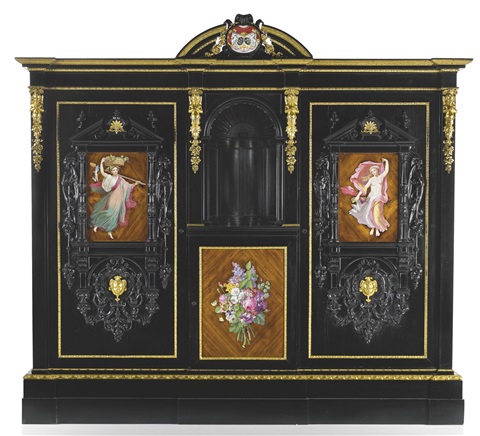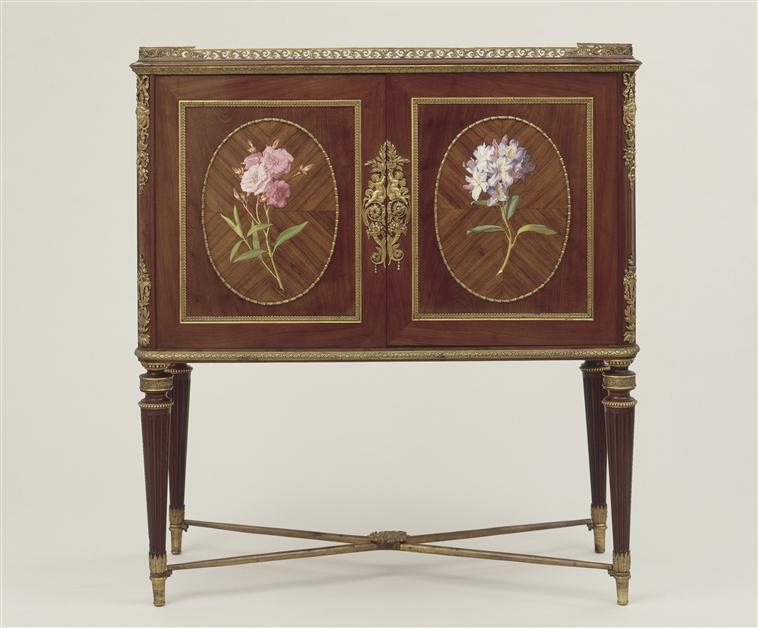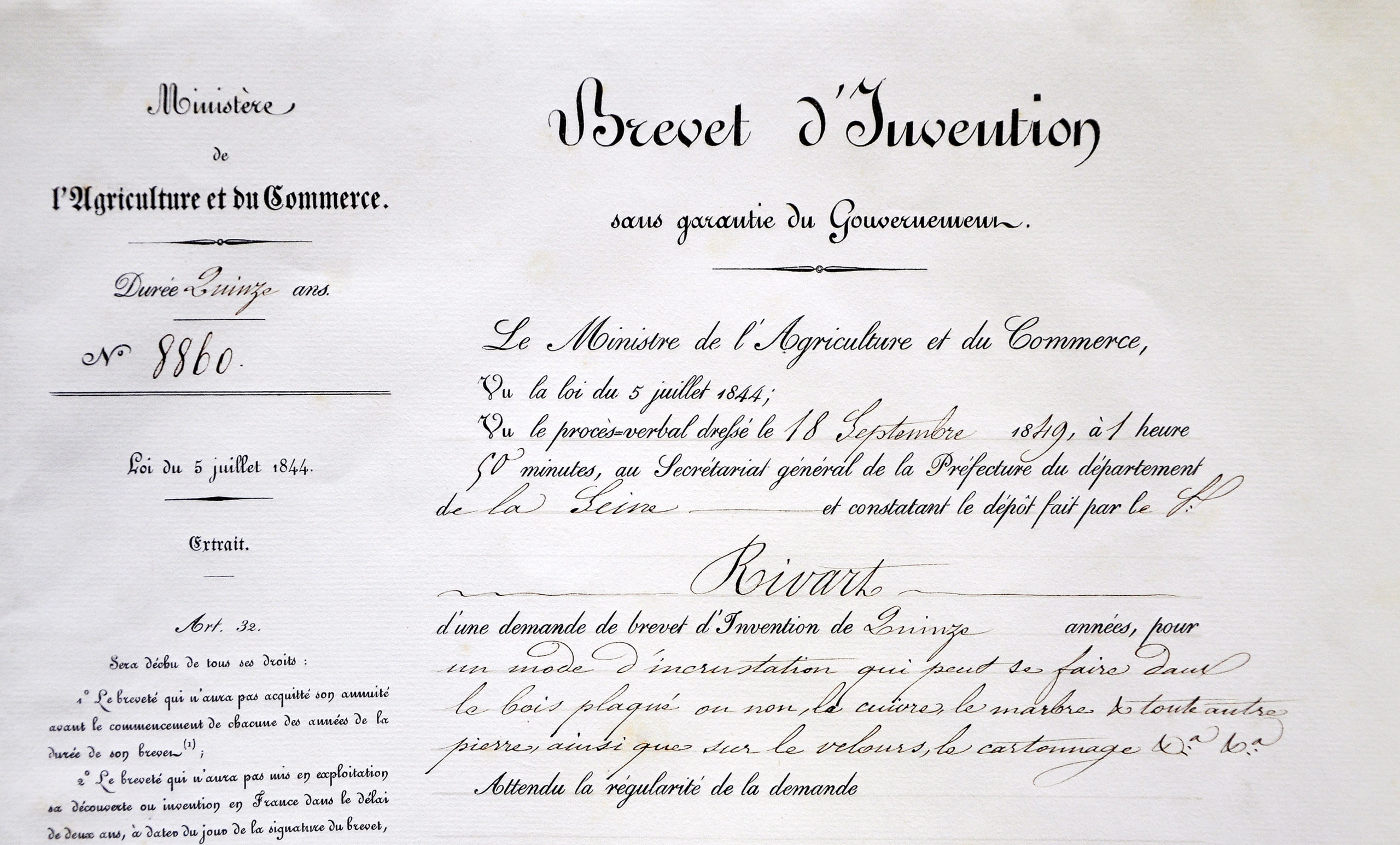Julien-Nicolas Rivart is the only artist that seem to have succeeded to produce an innovative marquetry, and have left the memory of his obstinacy and his determination. Certain about his ability and talent, he knew how to detach himself from the crowd and receive worldwide aknowledgment.
Birth and apprenticeship
Woodmaker as well as major painter on porcelain of the Second Empire, Julien-Nicolas Rivart was born on July 1rst, 1802 in the Paris of Napoléon I. The beginning of his life has left few traces, only making us suppose that he received an apprenticeship in a modest environment.
Paris in then economically shaken by the French Revolution and the Napoleonic wars. For the woodmakers, it is a time for important restrictions, imposed by the embargo, which will promote the use of local varieties, typical of the Restauration style.
The first workshops
Most informations we know seem to confirm these modest beginnings, because we only meet Rivart again in 1835, in a workshop settled in a popular area, at the 76, rue du Faubourg Saint-Martin. The workshop moved twice, the first time in 1837 at the 6, rue Sanson, and the second time in 1840 at the 16, rue de la Folie Méricourt, maybe because he struggled seeking for a clientele. In his words, those years were synonyms of “all types of sacrifices”, and of “a twenty years long perseverance”.
The year of the discover
It is in 1848 that Rivart developped a new marquetry technic which brought him suddenly into light. His life knew important changes then, right at the same time when Louis-Napoléon Bonaparte took over the power.
The Second Empire, proclaimed shortly after, saw the country modernising itself and the art industries were to prosper. With the end of the embargo, the exotic woods were again available for the luxury manufactures.
The patent
On September the 18th, 1849, Rivart got his new technic patented for 15 years, for « an inlay method which can be applied to wood, varnished or not, to copper, to marble, and to every other stone, as well as to velvet, to packaging, etc. ».
Under this general appellation, he aims for a material until then never seen in marquetry : porcelain. « Every research that have been made until now in this type of industry remained unsuccessful and […] I was the first to made this discover », he claimed in the memoire accompanying his patent. He fiercely defended the paternity of his invention, by patenting every possible improvment he made then.
Invention patent for the porcelain marquetry technic filed by Rivart
Collaboration with great artists
Thanks to this method he invented, Rivart became a major figure in decorative arts. With his technic, porcelain could be added without taking too much place, and without concealing the beauty of the wood. This invention which paternity he defended allowed him to collaborate with important artists, and to access some prestigious orders. The most important is Tahan, the Emperor’s woodmaker, but there was also Alphonse Giroux.
His workshop was then settled at the 1, rue de Normandie, in a dynamic district of the old Paris.
The first World's Fair
The World’s Fairs were to be really profitable to Rivart. He has gotten his idea just in time for these international meetings initiated by Prince Albert in London in 1851.
For this historic event, he benefited from the collaboration of Victor Paillard, a sculptor precisely in charge for Queen Victoria’s statue.
Both artists presented an important ebony and mahogany cabinet, putting to his best the painting on porcelain, with its contrasts between shadow and light. The foresaid cabinet is bought by the Duke Caumont de la Force and received 16 medals, amongst them the Prize medal.
The 1855 World's Fair
Noticed during the first World’s Fair, Rivart is crowned with success at the second one, which took place in Paris in 1855.
For his entering, Rivart asssociated himself with the great Maison Tahan, and to the painter of the Manufacture de Sèvres Pierre-Joseph Guérou, who was twenty years younger than him. The critics made his promotion : « A really ingenious innovation was brought to light by Rivart in the incrustation of furniture : it consists in the application of cut, painted porcelains in order to form flower bouquets, and replacing, sometimes for the best, the ordinary wooden mosaic. This principle allows distincted artists to adorn furniture. We have to signal his three panels cabinet, « of a quite good artistic aspect ».
Indeed, he displayed during this important exhibition pieces of furniture made out of rosewood tree, as well as a black marble table, both creations granting him a First class medal. His booth was noticed by the imperial couple, who congratulated him, while the Impress Eugénie bought him a jewellery cabinet now kept in the collections of the Musée de Compiègne.

Julien-Nicolas Rivart and Victor Paillard, cabinet presented at the Great Exhibition of 1851 and bought by the Duke Caumont de la Force
©Historismus Gallery, Brussels

Julien-Nicolas Rivart, Charon Frères, Pierre-Joseph Guérou, Jewellery cabinet presentend at the 1855 World’s Fair, bought by the Impress Eugénie, now kept in the Musée National du château de Compiègne.
©RMN (Château de Compiègne) / Franck Raux
The reknown
After the 1855 World’s Fair, Rivart is frequently requested for important orders.
Thus, two years later, in 1857, Tahan delivered a table adorned with porcelain inlays at the Palais des Tuileries.
In 1861, Rivart made a table for the Earl Charles André de Manneville, now kept at the Cité de la Céramique de Sèvres, and the year later he contributed at the layout of the French Imperial Commission for the 1862 World’s Fair.
At this date, Rivart exported 50 % of his production, mostly thanks to his successes at the World’s Fairs.
In particular, he delivered his marquetry to Frédéric Roux, a Parisian woodmaker which was familiar of the American market for having worked in New York.
Death
Julien-Nicolas Rivart died on February the 17th, 1867, letting his marble panels inlayed with porcelain for the coming World’s Fair unfinished.
Frédéric Roux presented them for him, but his absence was noticed.
Auguste Luchet, a writer for his generation, took note of this disparition and predicted : « No one will ever do what he has done ».
Posterity
The World’s Fair, establishing a « recap of the century », does not forget the favour Rivart’s inlayed porcelain had won under the Second Empire, by displaying one of his tables in the Napoléon III Salon.
Unfortunately, the delicacy of Rivart’s work in inlaying porcelain did not find a heir in the next years nor in the next century. The inlayed furniture with porcelain marquetry remain nowadays rare pieces, witnesses of the incredible inventivity of the second half of the 19th century.







